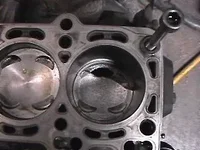How does nitrous oxide help an engine perform better?
This Question of the Day talks about how sodium chlorate acts as a way to store oxygen. You release the oxygen in sodium chlorate by heating it. It turns out that nitrous oxide (N20) works exactly the same way. When you heat nitrous oxide to about 570 degrees F (~300 C), it splits into oxygen and nitrogen. So the injection of nitrous oxide into an engine means that more oxygen is available during combustion. Because you have more oxygen, you can also inject more fuel, allowing the same engine to produce more power. Nitrous oxide is one of the simplest ways to provide a significant horsepower boost to any gasoline engine.
Nitrous oxide has another effect that improves performance even more. When it vaporizes, nitrous oxide provides a significant cooling effect on the intake air. When you reduce the intake air temperature, you increase the air's density, and this provides even more oxygen inside the cylinder.
The only problem with nitrous oxide is that it is fairly bulky, and the engine needs a lot of it. Like any gas, it takes up a fair amount of space even when compressed into a liquid. A 5-liter engine running at 4,000 rotations per minute (rpm) consumes about 10,000 liters of air every minute (compared to about 0.2 liters of gasoline), so it would take a tremendous amount of nitrous oxide to run a car continuously. Therefore, a car normally carries only a few minutes of nitrous oxide, and the driver uses it very selectively by pushing a button.
These links will help you learn more:

